|
|
|
Sort Order |
|
|
|
Items / Page
|
|
|
|
|
|
|
| Srl | Item |
| 1 |
ID:
094147
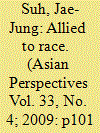

|
|
|
| 2 |
ID:
059910
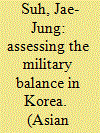

|
|
|
| 3 |
ID:
116629
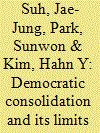

|
|
|
|
|
| Publication |
2012.
|
| Summary/Abstract |
This article uses dilemmas of cooptation to explain progress and limits in South Korea's democratic consolidation since its transition to democracy in 1987. The series of cooptations employed by both conservative and liberal forces has helped to consolidate democracy but also to limit the extent of democratic reforms.
|
|
|
|
|
|
|
|
|
|
|
|
|
|
|
|
| 4 |
ID:
153724
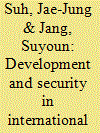

|
|
|
|
|
| Summary/Abstract |
In this paper, we contend that the nexus of security and development lies in the crux of challenges confronting human security and aid failure in North Korea. We first review academic and policy discourses concerning the security-development nexus. We then analyse how the nexus works out its logic in North Korea by exploring how insecurity and underdevelopment have fed into each other, producing a vicious cycle that complicates efforts to address human security in North Korea. In the third and main section, we examine the ways in which South Korea, the USA and the EU provided for assistance to North Korea from 1995 to 2012 at national and international policy levels. We analyse their approaches to international aid and identify differences and commonalities in them so as to better understand how aid giving exacerbates or mitigates the insecurity/underdevelopment and then impacts on the development-security nexus. We finally conclude with a consideration of various strategies to help overcome the dual challenges of underdevelopment and insecurity that besiege North Korea.
|
|
|
|
|
|
|
|
|
|
|
|
|
|
|
|
| 5 |
ID:
098398
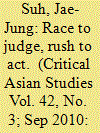

|
|
|
|
|
| Publication |
2010.
|
| Summary/Abstract |
On 26 March 2010, the Republic of Korea (ROK) Navy corvette Cheonan broke in half and sank near Baekryong-do Island off the coast of North Korea. Forty-six sailors lost their lives. Mysterious as the cause of the incident is, the ROK government's responses-the Navy's failure to communicate through the chain of command, the military's incompetence in rescue and salvage operations, the Ministry of National Defense's efforts to cover up basic facts, and the government's rush to blame North Korea as the culprit and take punitive measures-all added confusion and heightened already high tensions on the peninsula. This articles argues that the ROK government's report failed to substantiate its claim that North Korea attacked and sank the ship. Moreover, the author shows, its claim was based on internally inconsistent logic and likely fabricated data. The government's rash, and unsubstantiated, judgment was accompanied by saber-rattling against the North and scare tactics intended to silence domestic critics immediately before local government elections. Amidst the heightened tension caused by the incident, the U.S. administration succeeded in pressuring the Japanese prime minister Hatoyama to cave in to its demand to keep the Futenma base within Okinawa. Also it agreed to postpone the transfer of the wartime command control over the Korean military to the ROK until 2015. The United States, economically wounded by the financial crisis of 2008, found the heightened state of insecurity created by the Cheonan incident an opportune excuse to strengthen its allies and its military, if not political, influence in Northeast Asia, although its success may prove Pyrrhic in the long run.
|
|
|
|
|
|
|
|
|
|
|
|
|
|
|
|
| 6 |
ID:
187375
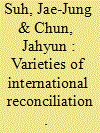

|
|
|
|
|
| Summary/Abstract |
After conflict, states occasionally succeed in reconciling with former adversaries. When they do, they do so in different ways. Some grudgingly sign a treaty to signal the end of a conflict. Others provide for not only reparations and compensations but also economic assistance as material evidence of reconciliation. Yet others offer apologies, official and unofficial, and engage their former adversaries in reflective dialog that transforms their relationship from enmity to amity. Is there a way to systemically organize different ways in which states reconcile? Can different types of reconciliation be identified? If so, what explains the types? We address these questions in this article. Based on our survey of war terminations in the post-World War II period, we identify four different types of reconciliation that former injurious states have made with their victim states – procedural, material, ideational, and substantial. We hypothesize that their choice of a reconciliation type can be explained in terms of a configuration of national interest and national reflection. In this article, we engage in a structured comparative analysis of the cases of reconciliation between France-Algeria, Japan-Korea, Germany-Czechoslovakia/Czech Republic, and Germany-Poland – that we argue closely resemble the four ideal types – and demonstrate that our hypotheses are confirmed. We conclude with a consideration of how likely it is for ideational and material reconciliation to develop into substantial reconciliation
|
|
|
|
|
|
|
|
|
|
|
|
|
|
|
|
|
|
|
|
|